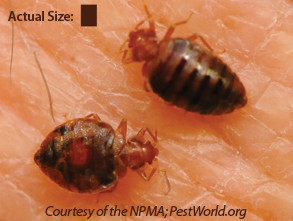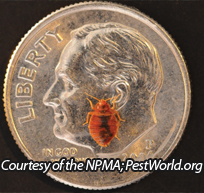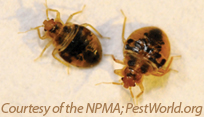Bed BugsMay Pest of the Month.

What are Bed Bugs & what causes them?
Often mis-spelled as bedbugs they are small, wingless and nocturnal insects that prefer to feed on blood and warm-blooded hosts. They are also called Travelers Bug, Mahogany Flats, Red Coats and Chinches. Mature bed bugs have a flattened body which let them hide in inconspicuous places like behind baseboards, floor cracks, under carpets and behind loose wallpaper. They often go unnoticed and stay close together. (photo to the left courtesy of: StarMaster on Flickr)
The name 'bed bugs' came from their preferred habitat of beds, places where people sleep and houses. Bed bugs have been around for thousands of years, in the early 1940's around the time of the war most bed bugs were eradicated using pesticides. Since 1995 bed bug cases have been on the rise mainly due to hitchhiking around the world. Bed Bugs re-entered the United States due to increased travel to locations around the globe that had increasing bed bug populations. They use luggage, humans and packages to travel undetected. Even if you have not traveled to another major city in the United States or the world, you can still get bed bugs due to them being on buses, trains, airplanes, ships and more.
Jump to section: Video | Appearance | Symptoms | Habitat | Life Cycle | Treatment | More Information
What You Need to Know About Bed Bugs
Here's a great video from the University of Florida IFAS extension for you to learn more about bed bugs. Here you will find information on how to identify them, the problems associated with bed bugs and more.
Watch this video as a full web page and click here.
Video from: University of Florida IFAS extension.
General Appearance
 Shape: Bed bugs are thin, flat and oval in shape.
Shape: Bed bugs are thin, flat and oval in shape.
Length: About 3/16" (or 3-5 mm) about the size of an apple seed. Mature bed bugs can be 4-5mm long.
Width: Bed bugs are less than 3 mm wide.
Smell: Bed bugs give off a musty, sweetish odor similar to stink bugs.
Color: A reddish-brown like a rusty brown to a deep red-brown. After a meal, they appear swollen and redder. Adult bed bugs who have not fed are a pale yellow-brown color. Nymph bed bugs who have not fed are tan colored.
Differences: Males have pointed abdomens. Females have broadly rounded abdomen tips.
Quick Facts:
- Adults are 1/4" to 3/8" long and heart-shaped in appearance.
- Females can produce 200-500 eggs in their entire lifetime. They can produce 1 to 5 eggs per day.
- One male can fertalize several females within a 24 hour span.
- Bed bugs require a blood meal before producing a set of eggs.
- Adult bed bugs can survive up to a year without eating.
- Bed bugs are closely related to stink bugs and give off almost the same smell.
- Bed bugs only have 6 legs and they only crawl. These pests have wings but are non-functional. Mature bed bugs can crawl about 4 feet per minute.
- Bed bugs feed at night, require at least 10 minutes per feeding and can consume up to 3 times their body weight in blood during a single feeding.
Treatments for bed bugs are very extensive and time consuming. Bed bug treatment includes all cracks, crevices, harborage areas with aerosols, residual materials and dusts as needed. Bed bug treatment also may require that infested bedding and items be discarded.
Also listen to recorded radio interviews with Roy Crain Jr. discussing this month's pest.
Symptoms
Since bed bugs are so small it can often be hard to find one. If you think you have a bed bug problem, give Live Oak Pest Control a call at (386) 362-3887 and we'll send out a trained specialist.
Some common signs:
- Have a distinctively sweet, yet unpleasant smell.
- Blood spotting (reddish-brown) on mattresses, bed covering and nearby furnishings.
- If they bite you, it can be itchy and leave minor welts on the skin. They can cause allergic reactions such as severe itching.
- Bites are similar to flea bites; usually appearing in rows or straight lines following the edge of an item or clothing that's lying against the host's skin at the time of feeding.
- The host will more than likely have inflamed skin lesions.
- Anxiety and paranoia can result from bed bug infestations.
Habitat
 Bed bugs are found worldwide due to human travelers who transport luggage, clothing, bedding, and furniture. Here in Florida, bed bugs can be found around poultry farms and around bats. Bed bugs are very adaptable to human environments. Bed bugs are normally found:
Bed bugs are found worldwide due to human travelers who transport luggage, clothing, bedding, and furniture. Here in Florida, bed bugs can be found around poultry farms and around bats. Bed bugs are very adaptable to human environments. Bed bugs are normally found:
- In warmer enviroments.
- Around cracks and crevices on beds and other furniture.
- Mattress seams, sheets and comforters.
- Behind baseboards.
- Behind electrical outlet plates.
- Behind picture frames.
- In hotels where they travel from room to room and in visitors' luggage.
- Bed bugs generally feed at night when the host is asleep.
Bed bugs can be found in institutions, businesses and homes such as single family homes, multi-family housing, apartments, hotels, hospitals, schools & colleges, school buses, office buildings, retail stores, movie theaters, public transportation vehicles such as trains, airplanes and buses, five-star hotels and even high-end clothing stores. (Fact provided by PestWorld.org)
Life Cycle
Female bed bugs can lie anywhere from one to twelve eggs per day and they are left on rough services or in cracks and crevices. The bed bug life cycle starting from an egg trough the adult stage takes approximately 4 - 5 weeks. Bed Bug eggs are attached to surfaces where they remain until they hatch. Each nymphal stage requires a single blood feed before molting to the next stage. Nymphs can live up to 3 months without feeding. Prior to feeding, nymphs look translucent (clear) in color. For every adult there will be 8 - 10 nymphs.
Click here to view the Bed Bug Life Cycle by the CDC.
Treatment
Treatments for bed bugs are very extensive and time consuming. Bed bug treatment includes all cracks, crevices, harborage areas with aerosols, residual materials and dusts as needed. Bed bug treatment also may require that infested bedding and items be discarded.
Listen to recorded radio interviews with Roy Crain Jr. discussing this month's pest.
More Information
- The Bed Bug Hub : National Pest Management Association
- Bed Bug Biology : Wisconsin Department of Agriculture Trade & Consumer Protection (PDF; you must have Adobe Acrobat or Reader installed)
- Bed Bugs : University of Florida Institute of Food & Agricultural Sciences
- Florida Bed Bug Report : BedBugReports.com
- Bed Bugs Gaining Ground : CNN
- Boase, C.J. (2004) Bed-bugs - reclaiming our cities. Biologist 51 (1), 1-4.
- MidMos United Solutions
